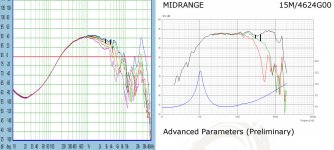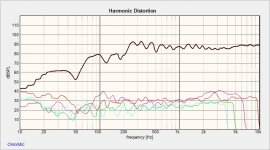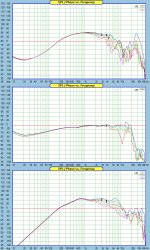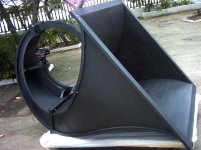Be careful with mini dsp.
Try running it in i2s in -> dsp -> Multi channel i2s out to real dacs. Will give you better sound.
Or can try PC -> Multi Channel USB -> I2S input dacs
Try running it in i2s in -> dsp -> Multi channel i2s out to real dacs. Will give you better sound.
Or can try PC -> Multi Channel USB -> I2S input dacs
Rubbish. The differences between the internal DACs and an external unit will be 30-70dB below the driver non-linearities and not be audible at all. It might be a nice finishing touch to add once the design is perfected, but after having done it with a couple of different external DACs the null remnants were in the >-100dBFS range.Be careful with mini dsp.
Try running it in i2s in -> dsp -> Multi channel i2s out to real dacs. Will give you better sound.
Or can try PC -> Multi Channel USB -> I2S input dacs
The driver in the studio models by ATC is able to put out 121 dB continuous, between 380 Hz and 3.5 KHz. Will this 'inferior' SM75-150 driver be able to deliver similar output levels, if appropriately driven and crossed over? There is no doubt in my mind that the system has to deliver the kind of SPLs that large format studio monitors do, consistently.
The ATC does look cool and impressively over-engineered. This review gives exact figures for the "S for Super" model:
http://studio-hifi.com/images/ATC75-150S_JeffBagby.pdf
SPL 2.83V / Meter (dB)= 93.13 dB
Fs = 282.583 Hz
Nominal power handling = 75 Watts
NOTE: the non "S" model that mortals can purchase is advertised as 91dB
This amount of output capability (91dB and 75 watts) is good, but not exceptional.
I also note that the ACM mid has a 3" dome, but requires a 6" cutout, and has a ~7" magnet. So in terms of bulk (centre-to-centre spacing), it seems reasonable to compare it to conventional drivers that have frames of 6" and 7"
This driver:
http://www.scan-speak.dk/datasheet/pdf/15m-4624g00.pdf
Has a 149mm frame - a trifle smaller than the cutout size of the ATC.
Sensitivity (2.83V/1m) = 92.4 dB
Resonance frequency [fs] = 100 Hz
Nominal power handling = 75 Watts
So it should play just as loud, in the same cabinet layout, with the same crossover points - although I'd probably choose a slightly lower bandwidth: 250Hz-3kHz.
A bonus is that the 15M doesn't require the awkward rear-mounting of the ATC midrange.
I haven't heard / measured this driver myself, but have it in mind for future projects. There are user published test results that look good:
Nice curves... - Scan-Speak 15M/4624G - Techtalk Speaker Building, Audio, Video Discussion Forum
I guess I'm trying to build the system around the midrange driver, as a clear, smooth midrange is what I have been missing with large two way designs - I keep hearing highest accolades for the ATCs, and am naturally tending towards them. However if the Volt or some other driver is likely to serve me better, my ears are all open.
A radically different midrange approach (that seems pretty impressive to me) in this post:
Planar Speaker Asylum
I note that Satie posted the above, in 2010, and he last edited his system in 2013. His system still says "midrange BG Neo 8 line array", so it must have been a keeper 🙂
The driver in the studio models by ATC is able to put out 121 dB continuous, between 380 Hz and 3.5 KHz. Will this 'inferior' SM75-150 driver be able to deliver similar output levels, if appropriately driven and crossed over? There is no doubt in my mind that the system has to deliver the kind of SPLs that large format studio monitors do, consistently.
...I guess I'm trying to build the system around the midrange driver, as a clear, smooth midrange...
The peak SPL figures for the ATC SLMM and normal variants are much the same: The difference lies in their distortion performance. The SLMM variant produces a noticeably "clearer" midrange due to its lower third harmonic distortion.
The difference is circumvented, however, if you are able to adopt current drive.
And while on current drive, a further advantage (although subjectively less important in my experience) in high power designs is that thermal compression is also circumvented. Note here that while thermal compression is stated as being inaudible (due to the long time constants involved), this applies to a single driver. In a multi-band system thermal compression is audible which might be of relevance in your designs too.
This is more comparison of the "S for Super" ATC dome to the Scanspeak cone.
The first image shows (on the left) Zaph's polars for the ATC. I rescaled this to match the grid on Scanspeak's spec sheet, and I marked the 30 degree lines at 3kHz and 4kHz. It looks like they have similarly wide dispersion up to 3kHz, but the (larger) cone is beaming by 4kHz.
The 2nd image is the distortion on the 15M, taken from the thread I linked earlier, plot described as
24", 5 msec, 1/12th smooth, drive level not checked. From this, it looks very good for use over 250Hz - 3kHz.
...so the 15M seems to compare well in
...assuming that 250Hz-3kHz rather than 380Hz-3.5kHz is an acceptable midrange bandwidth.
That seems great for a driver which is 1/10th the price and weight, and that doesn't require rear-mounting.
The final image is a comparison of the ATC's polars with two other 3" drivers (all info from Zaph's site). Again, I marked the 30 degree lines at 3kHz and 4kHz.
The cheap (currently $10 at Parts Express) conventional driver, the Hi-Vi B3S in the middle, has similarly wide dispersion to the ATC, and it stays good to 8kHz, whereas the ATC is quite messy by 8kHz.
The lower plot is the Tangband dome.
Based on this comparison, it doesn't seem like there is any magic about the dispersion pattern of a 3" dome compared to a cheap & humble 3" driver - wide dispersion seems to be largely a function of diaphragm size.
The first image shows (on the left) Zaph's polars for the ATC. I rescaled this to match the grid on Scanspeak's spec sheet, and I marked the 30 degree lines at 3kHz and 4kHz. It looks like they have similarly wide dispersion up to 3kHz, but the (larger) cone is beaming by 4kHz.
The 2nd image is the distortion on the 15M, taken from the thread I linked earlier, plot described as
24", 5 msec, 1/12th smooth, drive level not checked. From this, it looks very good for use over 250Hz - 3kHz.
...so the 15M seems to compare well in
- maximum SPL (the same)
- dispersion (the same below 3kHz)
- smooth response (the 15M has more bandwidth)
distortion
...assuming that 250Hz-3kHz rather than 380Hz-3.5kHz is an acceptable midrange bandwidth.
That seems great for a driver which is 1/10th the price and weight, and that doesn't require rear-mounting.
The final image is a comparison of the ATC's polars with two other 3" drivers (all info from Zaph's site). Again, I marked the 30 degree lines at 3kHz and 4kHz.
The cheap (currently $10 at Parts Express) conventional driver, the Hi-Vi B3S in the middle, has similarly wide dispersion to the ATC, and it stays good to 8kHz, whereas the ATC is quite messy by 8kHz.
The lower plot is the Tangband dome.
Based on this comparison, it doesn't seem like there is any magic about the dispersion pattern of a 3" dome compared to a cheap & humble 3" driver - wide dispersion seems to be largely a function of diaphragm size.
Attachments
it doesn't seem like there is any magic about the dispersion pattern of a 3" dome compared to a cheap & humble 3" driver - wide dispersion seems to be largely a function of diaphragm size
Indeed! Why should there be? Dispersion is primarily a function of diaphragm size. The advantages of a dome lie elsewhere...
And yes, dome break-up can be severe just out-of-band. There are a few changes to the design that can ameliorate the effects but that makes manufacture more difficult (and the driver less visually appealing maybe). ATC instead take the easier option and use a 4th order crossover instead.
The primary advantages stem from a (maximally) large voice coil diameter compared to an equivalent diameter cone driver, the structural integrity of the soft dome and the means by which it can be manufactured. Given the chosen diameter it would be difficult to design a more optimal conventional moving coil driver.
The 3" dome just then happens to work well over the conventionally defined "midband" - it is an engineering compromise. A 4" dome (of which ATC used to exhibit) extends the low frequency/maximum SPL but at the expense of its usable high frequency range, for example.
The 3" dome just then happens to work well over the conventionally defined "midband" - it is an engineering compromise. A 4" dome (of which ATC used to exhibit) extends the low frequency/maximum SPL but at the expense of its usable high frequency range, for example.
No discussion about the vc dia, but the structural rigidy of a doped cloth fabric dome is very questionable. For studio applications the heat dissipation of such a large vc may be an advantage. However, because of the lack of a real surround combined with the floppy structure of a soft dome assembly, this advantage is easily offset by the potential rocking of the assembly. I must admit, though, that ATC seems to have managed that issue. A resonant frequency of 300 Hz is and remains an issue however.
I beg to differ in the difficulties in designing a 3"cone driver. Take an XBL2 motor structure, a 35 mm vc and a decent Kurt Mueller cone and surround and you are there. Basically Vifa, Tympany and SS and now SB show the way. For some reason these companies seem, unlike ATC, to have never been interested in hi power/high excursion designs.
By the way, the ATC is a straight (albeit 3") rip off of the 2" SEL/ITT dome dating backing to 1970.
I beg to differ in the difficulties in designing a 3"cone driver. Take an XBL2 motor structure, a 35 mm vc and a decent Kurt Mueller cone and surround and you are there. Basically Vifa, Tympany and SS and now SB show the way. For some reason these companies seem, unlike ATC, to have never been interested in hi power/high excursion designs.
By the way, the ATC is a straight (albeit 3") rip off of the 2" SEL/ITT dome dating backing to 1970.
the structural rigidy of a doped cloth fabric dome is very questionable
Not questionable at all given the job is does. Without the rigidity imparted by the dome structure it is instead questionable whether such a well-damped diaphragm would be possible.
because of the lack of a real surround combined with the floppy structure of a soft dome assembly, this advantage is easily offset by the potential rocking of the assembly... I must admit, though, that ATC seems to have managed that issue
Yes they have by virtue of the double suspension that their dome manufacturing process allows - and with a gap width much smaller than would otherwise be possible to achieve reliably - or indeed is much in evidence in other drivers.
It would be very interesting to find out figures for drive unit failures - especially from such high power designs. I know of one study done with a number 12" drivers that I believe was carried out by EAW (if anyone knows the full details?) where the design constraints imposed by different manufacturing methods were clearly demonstrated. It is in these largely overlooked engineering aspects where I believe ATC have their biggest advantage.
But I am intrigued as to why you think 300Hz resonance remains an issue?
300 Hz is an issue because it only allows for a cutoff at minimal 750Hz, 4th order acoustic. Shallower slopes or lower x/o freqs will dramatically increase the risk for blow up.
For any 8" or 10" unit 750Hz is not an issue, but some real subwoofers do not even make it to 750 Hz decently. The inflexibility of 3" domes is i.m.h.o. the main reason they have mostly vanished from the scene. 25 years ago the Vifa and Seas units were all over the place. Nowadays they have become rare birds, although not extinct.
I still happen to have some these around, so a I am not against them, but have never felt they offered any advantage over a decent 4"coned unit, that can be used from 375-400 Hz upward. And then there is the price of the ATC..
For any 8" or 10" unit 750Hz is not an issue, but some real subwoofers do not even make it to 750 Hz decently. The inflexibility of 3" domes is i.m.h.o. the main reason they have mostly vanished from the scene. 25 years ago the Vifa and Seas units were all over the place. Nowadays they have become rare birds, although not extinct.
I still happen to have some these around, so a I am not against them, but have never felt they offered any advantage over a decent 4"coned unit, that can be used from 375-400 Hz upward. And then there is the price of the ATC..
300 Hz is an issue because it only allows for a cutoff at minimal 750Hz, 4th order acoustic
I disagree. Any "high power"/high SPL design would be non-sensical to attempt without an active crossover. Even in passive mode ATC notch out the resonance; In active modes it is simply not an issue. (And re my earlier comments on manufacturing processes, I have yet to see a blown-up one - anybody?).
The inflexibility of 3" domes...
Again I disagree. The 3" dome is an exceptionally good engineering compromise for a mid-band driver and entirely usable from 375-400Hz with increased power handling compared to that a 4" diameter cone would likely offer.
If you need more SPL then 3" domes also make exceptionally good array elements if a budget allows. I would instead recommend instead adding more speakers but that is another thread perhaps.
I suspect the reason for their absence is a price-performance-quantity issue and little to do with their performance.
And tests of the actual proprietary ATC (SL) unit are unlikely unless ATC have chosen to publish them (?).
I think ATC's standard high-pass xo for the '75-150 is 380Hz, which seems to work fine, and IIRC, is 24dB/ octave acoustic. These units have decades of proven, reliable use in studio monitors, played loud. Can't imagine where 750Hz is coming from. No idea if the Scan-speak unit mentioned is better or worse in the same application, but in the context of complete ATC speakers I've heard them sound very good. They are expensive though...
I think ATC's standard high-pass xo for the '75-150 is 380Hz, which seems to work fine, and IIRC, is 24dB/ octave acoustic
Almost... The crossovers are 4th-order electronic slopes, superimposed therefore on the acoustic response. Whether the resulting difference is audible is another debate.
As to any other mass-manufactured drivers, there are reasons why the ATC is so reliable in such high power applications and that is indeed reflected in their price...
The 3" dome is an exceptionally good engineering compromise for a mid-band driver and entirely usable from 375-400Hz with increased power handling compared to that a 4" diameter cone would likely offer.
Discussing power, I don't think it is meaningful to compare the ATC to a 4" cone, because the ATC has an integral horn and large frame that effectively makes it a ~7" driver*
The example I gave (post 23) is a cone driver with a slightly smaller frame that appears to have the same power handling and the same output capability (same efficiency and 75W 100 hour power rating).
*taking this to an extreme: I wouldn't compare the pictured unit to a cone driver from a TV, just because both happen to have 2" diaphragms.
Attachments
Last edited:
Discussing power, I don't think it is meaningful to compare the ATC to a 4" cone, because the ATC has an integral horn and large frame that effectively makes it a ~7" driver
No. The horn loading is minimal: It is there largely to protect the dome and enable the drive unit to be mounted given its motor assembly is considerably larger than diaphragm.
The comparison to a 4" cone driver was to make clear one of the main dome advantages of maximum possible voice coil diameter (for a given and nominally rigid diaphragm area).
Also relevant in this thread is the subject of maximum power ratings. I hinted at the results of a survey carried out by EAW where, of all the 12" drive units tested at their rated 100W (the ATC is actually rated at only 75W), only two survived beyond a minute or so: I believe an RCF driver survived in the order of an hour; The ATC driver was still going some 30 or so hours later when the test was switched off. I hope somebody can supply full details of this test (?).
While continuous 100W power inputs may not be typical, the manufacturing methods that contribute to ATC's genuine power handling ratings lead to significantly lower heat stresses and contribute to their very well earned reputation for reliability. The same manufacturing processes are also employed in the 3" dome and therefore similarly attributable (in part) to its outstanding reputation.
Such manufacturing issues should not be under-estimated - particularly in high powered designs such as is the subject of this thread. Their proper consideration in this forum is somewhat conspicuous...
The comparison to a 4" cone driver was to make clear one of the main dome advantages of maximum possible voice coil diameter (for a given and nominally rigid diaphragm area).
Is it the heat dissipation for studio use you refer to as being advantageous of a large vc dia? I fully agree on overrated power handling specs of many drivers, although in ProAudio these myths are easily busted and exposed by the sheer number of burnt out units returned to manufacturers.
Is it the heat dissipation for studio use you refer to as being advantageous of a large vc dia? I fully agree on overrated power handling specs of many drivers, although in ProAudio these myths are easily busted and exposed by the sheer number of burnt out units returned to manufacturers.
in ProAudio these myths are easily busted and exposed by the sheer number of burnt out units returned to manufacturers
...with ATC possibly being the exception for the reasons cited previously amongst others.
Is it the heat dissipation for studio use you refer to as being advantageous of a large vc dia?
Heat dissipation or rather power handling capacity therefore is one advantage.
- Status
- Not open for further replies.
- Home
- Loudspeakers
- Multi-Way
- ATC SCM200 ASL Pro



